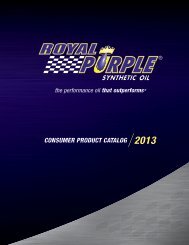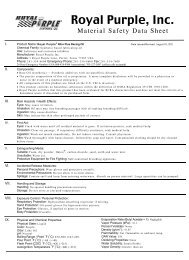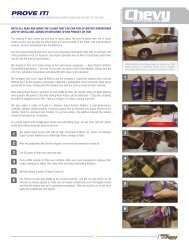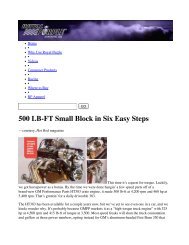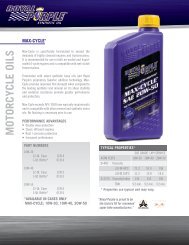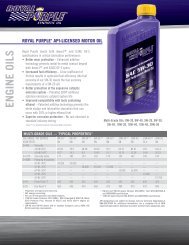MSDS - Royal Purple
MSDS - Royal Purple
MSDS - Royal Purple
Create successful ePaper yourself
Turn your PDF publications into a flip-book with our unique Google optimized e-Paper software.
MAX-CLEAN Page 4OCTOBER 10, 2012(section 5 continued)FLAMMABLE LIMITS IN AIRLEL: N/AUEL: N/AEXTINGUISHING MEDIA:Carbon dioxide, foam or dry chemical.FIRE & EXPLOSION HAZARDS:Combustible Liquid. Can burn in a fire, releasing toxic vapors, fumes,and smoke, including carbon monoxide and organic vapors. Containersexposed to intense heat from fires should be cooled with water to preventvapor pressure buildup which could result in container rupture orexplosion.FIRE FIGHTING INSTRUCTIONS:As in any fire, wear self-contained breathing apparatus pressure-demandMSHA/NIOSH (approved or equivalent) and full protective gear.Avoid breathing smoke and vapor.COMBUSTION PRODUCTS:Hazardous decomposition products are oxides of carbon and nitrogenincluding CO and CO2.6. ACCIDENTAL RELEASE MEASURESSAFEGUARDS (PERSONNEL):Wear appropriate personal protective equipment (See Section 8). Evacuatenon-emergency personnel to a safe area.If applicable, report spills to the proper environmental agencies asrequired by federal, state and local regulations.INITIAL CONTAINMENT:Eliminate all sources of ignition - Heat, sparks, flame, electricity, andimpact. Contain spilled material with dikes or absorbents. Do not allowmaterial to enter soil, surface water, or sewer system. If possible, tryto contain floating material.LARGE SPILLS PROCEDURE:Stop the source of the leak, if it is safe to do so. Contain spilledmaterial. Vacuum or sweep up material and place in a disposal container.Absorb residue with inert material (e.g. dry sand or earth), then placein a chemical waste container. Do not flush to sewer. Useexplosion-proof equipment during clean-up.
MAX-CLEAN Page 5OCTOBER 10, 2012(section 6 continued)SMALL SPILLS PROCEDURE:Absorb spills with inert material. Transfer to a chemical waste containerand dispose of properly. Spills are extremely slippery and should becleaned up immediately.MISCELLANEOUS:Treat or dispose of in accordance with all federal, state, and localrequirements.7. HANDLING AND STORAGEHANDLING (PERSONNEL): DO NOT PRESSURIZE, CUT, WELD, BRAZE, SOLDER, DRILL, GRIND,OR EXPOSE SUCH CONTAINERS TO HEAT, FLAME, SPARKS, STATIC ELECTRICITY, OR OTHERSOURCES OF IGNITION; THEY MAY EXPLODE AND CAUSE INJURY OR DEATH.Ground and bond containers when transferring material.Avoid contact with eyes. Avoid prolonged or repeated contact with skin.Keep away from food and drinking water.HANDLING (PHYSICAL ASPECTS):Secure container after each use. Store in a cool dry, secure area. Keepout of reach of children. Ground containers when transferring material.Avoid contact with strong oxidizing agents.Empty drums should be completely drained, properly bunged, and promptlyreturned to a drum reconditioner, or properly disposed of.STORAGE PRECAUTIONS:Store in a tightly closed container. Store in a cool dry place.Eliminate all sources of ignition - heat, sparks, flame, electricity,impact and friction. Contact with hot surfaces may ignite the product.8. EXPOSURE CONTROLS / PERSONAL PROTECTIONENGINEERING CONTROLS:Local exhaust ventilation may be necessary to control any air contaminantsto within their TLVs during the use of this product.EYE / FACE PROTECTION REQUIREMENTS:Wear safety glasses with side shields (or goggles) and a face shield.SKIN PROTECTION REQUIREMENTS:Wear protective gloves to minimize skin contamination. When prolonged orfrequently repeated contact could occur, use protective clothing
MAX-CLEAN Page 6OCTOBER 10, 2012(section 8 continued)impervious to this material.Wash hands thoroughly after handling.RESPIRATORY PROTECTION REQUIREMENTS:Under normal use conditions, with adequate ventilation, no specialhandling equipment is required. If anticipating close contact with thisproduct or its mist, local ventilation may be required to keep exposurebelow limits.EXPOSURE GUIDELINES:SOLVENT NAPHTHA, PETROLEUM, LIGHT AROM.OSHA TWA: 500 ppm1,2,4-TRIMETHYLBENZENEACGIH TWA: 25 ppm1,3,5-TRIMETHYLBENZENEACGIH TWA: 25 ppmNAPHTHALENEOSHA PEL: 10 ppm, 50 mg/m^3OSHA TWA: 10 ppm, 50 mg/m^3ACGIH TWA: 10 ppm, 52 mg/m^3OSHA STEL: 15 ppm, 75 mg/m^3ACGIH STEL: 15 ppm, 7 mg/m^39. PHYSICAL AND CHEMICAL PROPERTIESFORM ..................: LiquidCOLOR .................: <strong>Purple</strong>ODOR ..................: HydrocarbonSOLUBILITY IN WATER ...: NilSPECIFIC GRAVITY ......: 0.832 at 60 Deg F (Water = 1)BULK DENSITY ..........: 6.929 Pounds per Gallon at 60 Deg FpH ....................: Not applicable10. STABILITY AND REACTIVITYSTABILITY:Stable at normal temperatures and storage conditions.POLYMERIZATION:Hazardous polymerization will not occur.INCOMPATIBILITY WITH OTHER MATERIALS:Avoid contact with strong oxidizing agents, such as nitric and sulfuricacids, halogens, hydrogen peroxide and chlorinating agents. May burn orreact violently with fluorine/oxygen mixtures with 50-100% fluorine.Decomposes with heat.
MAX-CLEAN Page 7OCTOBER 10, 2012(section 10 continued)DECOMPOSITION:In the case of fire, a complex mixture of airborne solids, liquids andgases, including carbon monoxide, carbon dioxide, smoke and other organiccompounds will be evolved when this material undergoes combustion orthermal or oxidative degradation.11. TOXICOLOGICAL INFORMATIONEYE EFFECTS:Solvent Petroleum Naphtha, slightly irritating (rabbit).SKIN EFFECTS:Solvent Petroleum Naphtha, no deaths reported at 4 ml/kg (Rat). Slightlyirritating (rabbit, 4 hour(s)).ACUTE ORAL EFFECTS:Solvent Petroleum Naphtha, LD50, 10 ml/kg in rats.ACUTE INHALATION EFFECTS:Solvent Petroleum Naphtha, no deaths at 710 ppm (v) (Rat) 4 Hour (s).MISCELLANEOUS:Please contact supplier for additional toxicological information.12. ECOLOGICAL INFORMATIONMISCELLANEOUS:Please contact supplier for ecological information.13. DISPOSAL CONSIDERATIONSWASTE DISPOSAL:Do not dispose of into waste water treatment facilities. Treat ordispose of waste material in accordance with all local, state/provincial,and national requirements.This material, if discarded, is considered a hazardous waste under RCRARegulation 40 CFR 161.14. TRANSPORTATION INFORMATIONPRODUCT LABEL .............: MAX-CLEAN Fuel System Cleaner and StabilizerD.O.T. SHIPPING NAME ......: Not regulated
MAX-CLEAN Page 9OCTOBER 10, 2012NFPA SYMBOLFIRETOXICITY1 0 RACTIVITY0PERSONAL PROTECTIONINDEXHMIS SYMBOLHEALTHFLAMMABILITY 1REACTIVITY 0PPIB**********************************************************************This information is furnished without warranty, expressed or implied,except that it is accurate to the best knowledge of <strong>Royal</strong> <strong>Purple</strong>, LLCThe data on the sheet are related only to the specific materialdesignated herein. <strong>Royal</strong> <strong>Purple</strong>, LLC assumes no legal responsibilityfor use or reliance upon these data.**********************************************************************END OF <strong>MSDS</strong>**********************************************************************



